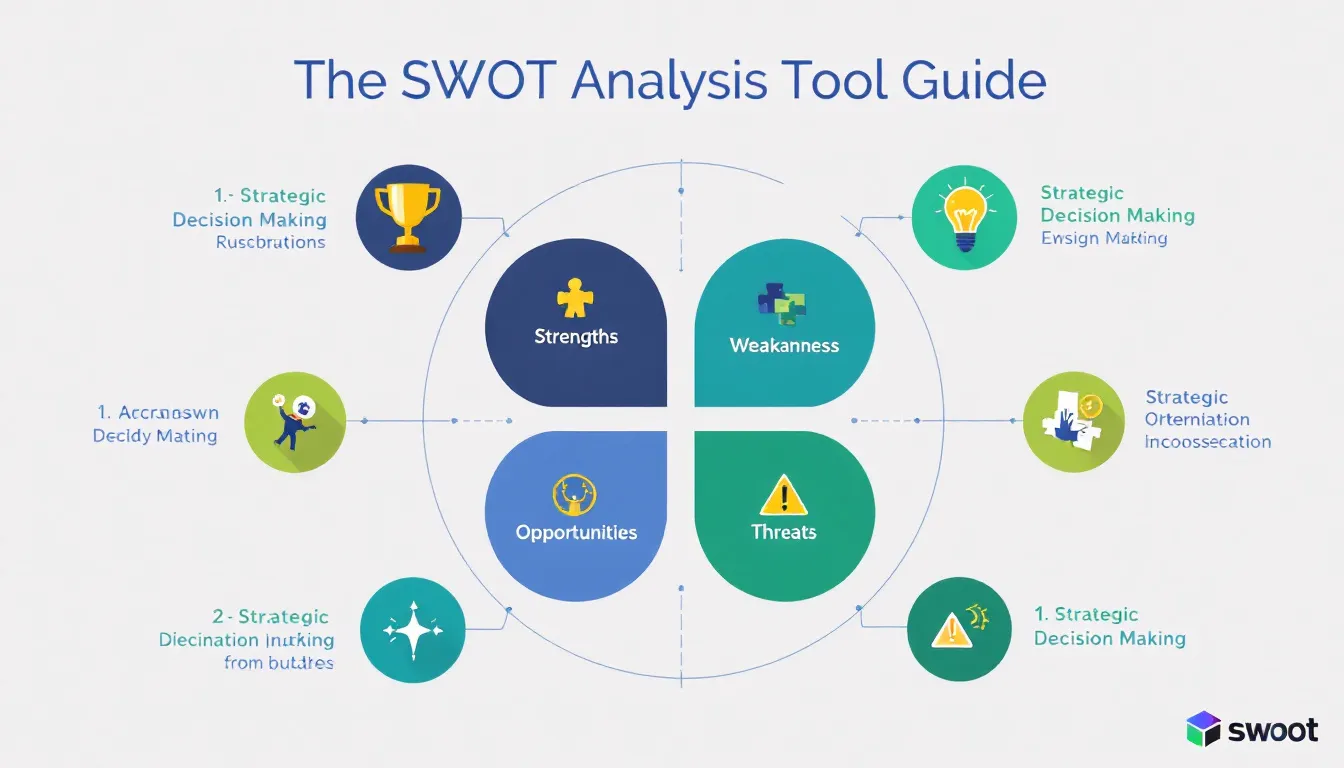Is this tool helpful?
How to Use the SWOT Analysis Tool Effectively
Use this free SWOT analysis generator to evaluate your brand’s strategic position precisely and quickly. Below are detailed instructions for each field and sample inputs to guide your entries.
- Brand Name: Enter the full official name of your brand or company. For example: “Blue Horizon Airlines” or “GreenTech Innovations”.
- Industry/Sector: Specify the primary market or industry category your brand operates in. Examples include “Renewable Energy” or “Luxury Hospitality”.
- Brand Description: Describe your brand’s core products or services, its current market role, and unique strengths. You might write: “A mid-sized solar panel manufacturer focusing on residential energy solutions with a growing market share in North America.” or “A boutique hotel chain known for personalized guest experiences and eco-friendly practices.”
- Main Competitors: (Optional) List your top competitors, one per line. Example entries: “SolarCity”, “SunPower Corporation” for energy, or “Marriott International”, “Hilton Hotels” for hospitality.
- Target Audience: (Optional) Define the main customer groups you serve, including demographics and preferences. Examples: “Environmentally conscious homeowners aged 30-50” or “Affluent travelers seeking sustainable luxury stays.”
Introducing the Free SWOT Analysis Generator Tool
This SWOT analysis tool helps you perform a thorough evaluation of your brand’s strengths, weaknesses, opportunities, and threats. The tool transforms your inputs into a clear, organized SWOT matrix, providing valuable insight into your brand’s competitive environment.
Designed for business owners, marketers, and strategists, it simplifies strategic planning by identifying internal and external factors influencing your brand’s success. You can use it for startups, established companies, or product lines to build actionable strategies tailored to your market.
Key Benefits of Using This SWOT Analysis Generator
- Quick and Structured Results: Generate a well-organized SWOT report in minutes without needing extensive strategic planning knowledge.
- Improved Strategic Focus: Pinpoint key business strengths and weaknesses alongside market opportunities and threats to guide decision-making.
- Resource and Time Efficiency: Automate your SWOT analysis process to save effort and maintain consistency across evaluations.
- Clear Communication: Easily share insightful analysis with stakeholders and team members to align strategies and goals.
Practical Use Cases for the SWOT Analysis Tool
You can use this tool in a wide range of strategic planning situations. It helps assess business health, explore new markets, and prepare for competitive challenges.
Example 1: Local Coffee Shop
- Strengths: High-quality, locally sourced coffee beans and strong community reputation.
- Weaknesses: Limited seating capacity and no online ordering system.
- Opportunities: Growing demand for specialty coffee and expansion into catering services.
- Threats: New coffee chains opening nearby and rising supplier prices.
Example 2: eCommerce Fashion Brand
- Strengths: Innovative designs and strong social media following.
- Weaknesses: Dependence on third-party logistics and limited international shipping.
- Opportunities: Expansion into men’s apparel and partnerships with influencers.
- Threats: High competition in online fashion and fluctuating material costs.
How This SWOT Analysis Tool Supports Your Business Needs
Enhancing Strategic Decision-Making
Use the generated SWOT matrix to make informed decisions by:
- Identifying your brand’s core competitive advantages
- Targeting areas for operational or product improvement
- Spotting emerging market trends and external opportunities
- Preparing for and mitigating potential business threats
Optimizing Business Performance
The analysis helps allocate resources wisely through:
- Performing gap analysis between current status and goals
- Prioritizing initiatives that bring the highest impact
- Planning risk management strategies
- Focusing on growth potential and new market niches
Best Practices for Using the SWOT Analysis Tool
Collect Comprehensive and Accurate Data
- Gather inputs from different departments and stakeholders
- Include recent market research and competitor information
- Review and update your data regularly to stay current
Create Actionable Plans Based on Your SWOT
- Focus on high-priority opportunities and critical weaknesses
- Set clear objectives and deadlines for improvement projects
- Allocate adequate resources to key initiatives
- Monitor progress using measurable KPIs
Frequently Asked Questions About SWOT Analysis
How often should I update my SWOT analysis?
You should update your SWOT analysis every 3 to 6 months, depending on market dynamics and business changes. Regular updates keep your strategy aligned with current realities.
Can this tool help with personal career planning?
Yes, you can adapt this SWOT analysis generator for personal use to evaluate your strengths, weaknesses, opportunities, and threats in career development.
What makes SWOT analysis effective?
An effective SWOT analysis relies on honest self-assessment, thorough data collection, and objective evaluation of both internal and external factors.
How can I get the most out of my SWOT analysis?
Involve your team in the analysis for diverse perspectives, focus on concrete insights, keep the analysis clear and specific, and update it regularly to reflect new information.
Should I share the SWOT results with my team?
Sharing your SWOT analysis helps build transparency, fosters strategic alignment, and encourages collaborative problem-solving across your organization.
How do I prioritize actions after SWOT analysis?
Prioritize actions by assessing their impact on your business goals, required resources, time frame for implementation, and associated risks.
Important Disclaimer
The calculations, results, and content provided by our tools are not guaranteed to be accurate, complete, or reliable. Users are responsible for verifying and interpreting the results. Our content and tools may contain errors, biases, or inconsistencies. Do not enter personal data, sensitive information, or personally identifiable information in our web forms or tools. Such data entry violates our terms of service and may result in unauthorized disclosure to third parties. We reserve the right to save inputs and outputs from our tools for the purposes of error debugging, bias identification, and performance improvement. External companies providing AI models used in our tools may also save and process data in accordance with their own policies. By using our tools, you consent to this data collection and processing. We reserve the right to limit the usage of our tools based on current usability factors.







